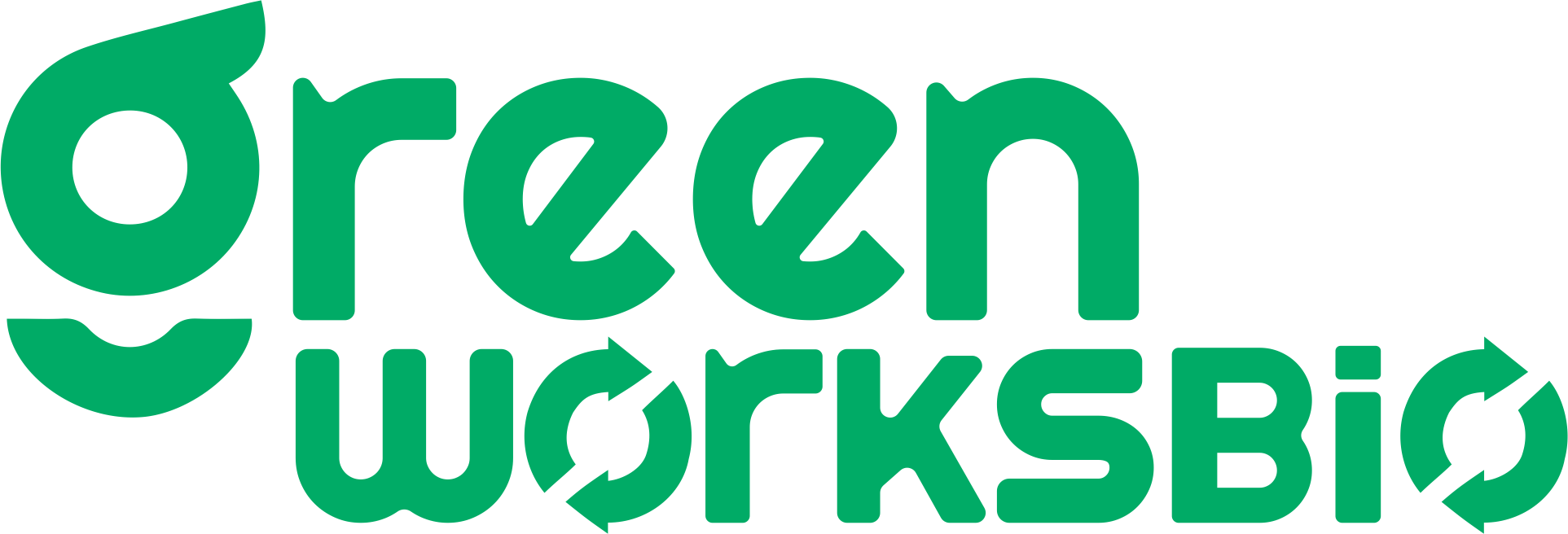TL;DR
- Eco friendly transparent packaging supports sustainability without compromising visibility or functionality.
- Transparent eco friendly packaging builds consumer trust and brand value.
- Compostable transparent materials offer a certified solution to plastic bans and pollution.
- Greenworksbio offers certified compostable transparent bags tailored for India’s evolving waste and compliance landscape.
Plastic pollution in India has reached alarming levels, with the country generating over 9.3 million tonnes of plastic waste every year, accounting for 20% of global plastic. Among the most frequently discarded items are transparent plastic bags, wrappers, and packaging films.
But there’s a shift underway. Brands are embracing eco-friendly transparent packaging, not just for compliance, but to show accountability, reduce environmental impact, and align with the values of today’s end consumers. From food-grade cellophane alternatives to compostable bag options with direct food contact capabilities, India is on the cusp of an eco-packaging revolution.
This blog unpacks the rise of eco-friendly transparent packaging in India, its benefits for businesses, and how to make the switch sustainably.
What Is Eco Friendly Transparent Packaging, and Why Is It Important?
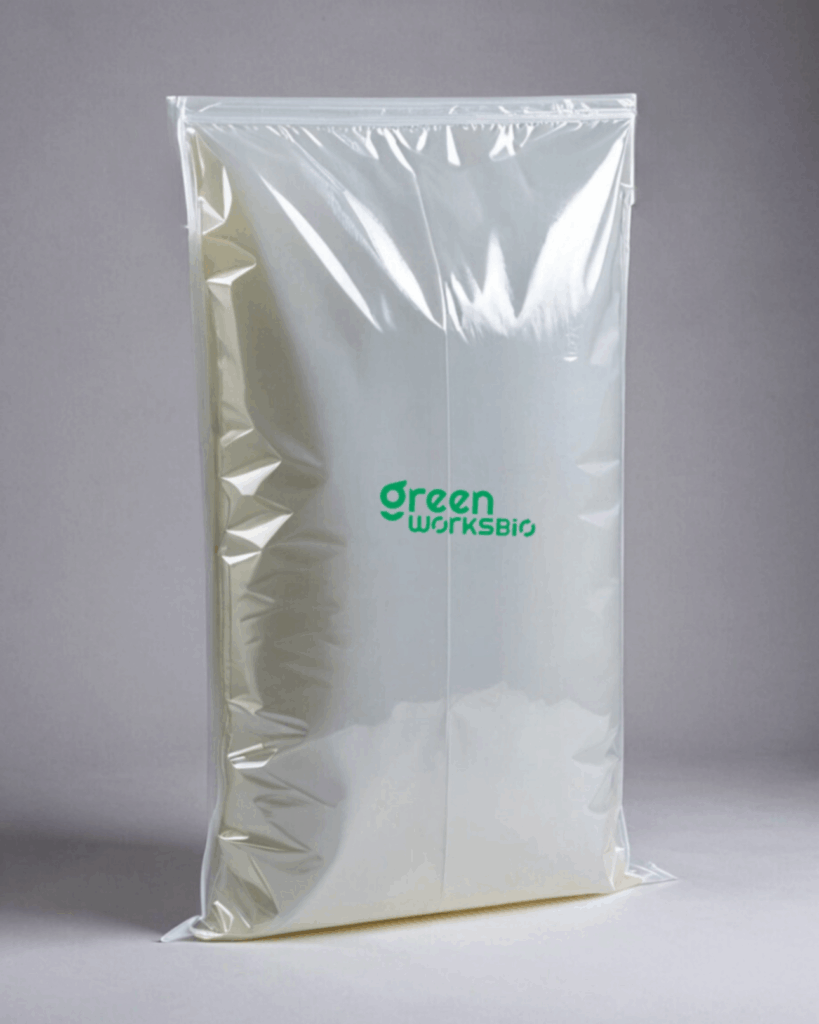
Transparent eco friendly packaging refers to materials that are both see-through and sustainably made, typically from compostable, recyclable, or biodegradable sources. Unlike traditional plastic films that linger in landfills, these materials break down naturally or can be safely reused.
Here’s why it matters:
- Meets new FSSAI and CPCB regulations targeting single-use plastics.
- Supports carbon testing and emission reduction goals.
- Prevents harmful residues in packaging food items.
- Offers minimal packaging solutions with high visibility and shelf appeal.
Compostable, Recyclable, and Conventional Transparent Packaging: What’s the Difference?
With so many packaging options available, it’s important to understand how different types of packaging material promote sustainability, safety, and responsible disposal. The table below compares compostable, recyclable, and conventional transparent packaging to help you make an informed choice.
| Feature | Compostable Transparent Packaging | Recyclable Transparent Packaging | Conventional Plastic |
|---|---|---|---|
| Material Source | Renewable content (e.g. PLA, cellulose) | Petroleum-derived but recyclable | Fossil fuels |
| Degradation Time | 90–180 days in proper environment | Can be recycled if sorted properly | 500+ years in landfills |
| End-of-Life Impact | Leaves no harmful residues | Depends on recycle codes & facility | Persistent microplastics |
| Certifications | Certified compostable film, European EN, FSC | May have general recycling symbol | None required |
| Food Safety | Meets FDA requirements, safe for direct food contact | Often approved, but varies | May leach toxins |
| Disposal Method | Home or industrial composting | Requires dedicated recycling systems | Disposal in mixed waste |
Why Choose Eco Friendly Transparent Packaging for Indian Businesses?
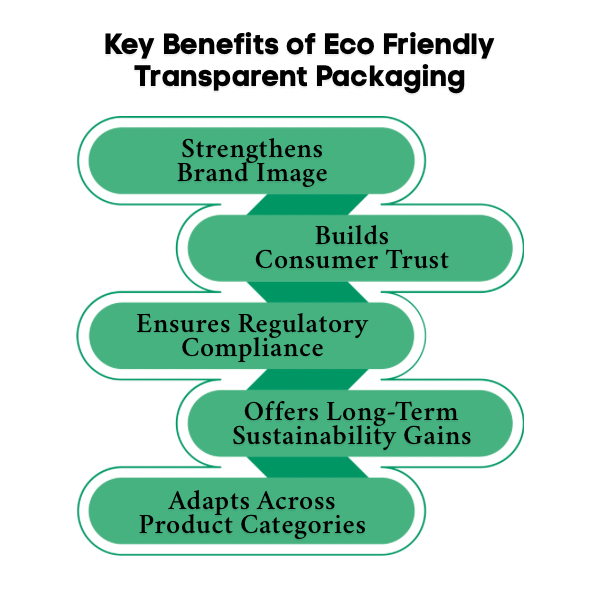
Switching to eco friendly transparent packaging isn’t just a green trend; it’s a strategic move for Indian businesses. Below, we explore the key business advantages of making the switch.
1. How Can Sustainable Packaging Strengthen Your Brand Image?
Businesses that adopt friendly packaging options build stronger reputations. Transparent materials make your product visible while showing you have nothing to hide, especially when paired with regenerative organic practices or vegan product claims. Using eco clear bags or eco food packaging solutions positions your business as progressive, ethical, and future-ready.
2. How Does Eco Friendly Packaging Build Customer Trust?
Indian consumers are becoming increasingly eco-aware and actively seek out brands with sustainable values. When your business uses eco-friendly bags or food pouches, it shows a commitment to health, safety, and environmental responsibility. Added functional benefits like scent barrier, oxygen transfer rate control, and higher moisture barrier coatings protect product quality, and foster long-term customer trust.
3. How Eco-Packaging Can Help You Meet Indian and Global Regulations?
Eco-friendly transparent packaging helps your brand comply with India’s Plastic Waste Management Rules and Indian regulations like ISO 17088 and CIPET standards. This is especially important for products with direct food contact, where safety certifications matter. Adopting certified materials ensures smoother inspections, builds buyer confidence, and strengthens your export-readiness.
4. Is Switching to Compostable Packaging a Smart Long-Term Investment?
Unlike conventional plastic that stays in landfills for hundreds of years, plastic alternatives for packaging, such as compostable and recyclable materials, break down safely, leaving no harmful residues. This shift reduces your environmental footprint and helps align your brand with carbon testing and sustainability goals. It’s a long-term investment in both your brand’s future and the planet’s.
5. Which Products Work Best with Eco Friendly Transparent Packaging?
Eco-friendly transparent packaging works for a wide range of products. Whether you’re in apparel, handmade gifting, packaging food, or shipping, materials like glassine paper, compostable cello bags, and certified compostable film offer visibility and protection without the plastic guilt. This flexibility allows Indian businesses to maintain aesthetics and function while adopting friendly materials.
Learn more about how packaging choices affect emissions in our blog: What Is Carbon Footprint? Understanding Its Impact.
Which Industries Benefit the Most From Transparent Packaging?
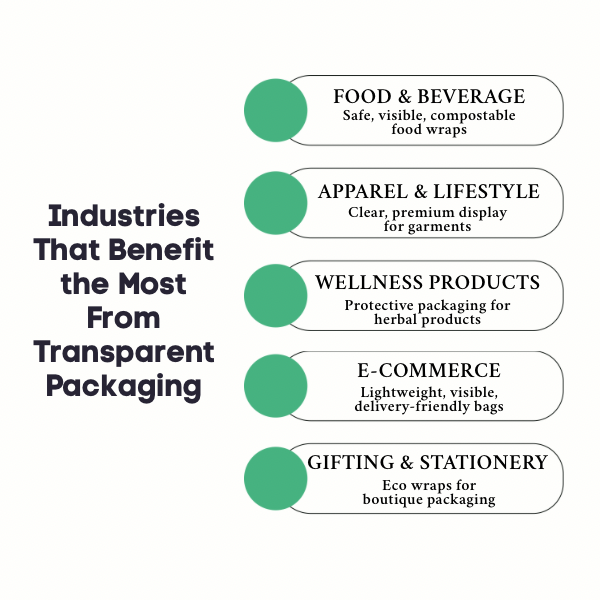
Eco-friendly transparent packaging is incredibly versatile and can add value across multiple sectors. While almost any business can benefit from sustainable, see-through materials, some industries stand to gain more, especially those where product visibility, compliance, and presentation matter.
1. Food & Beverage
From packaged snacks to fresh produce and takeaway items, food businesses need packaging that’s both functional and compliant. Certified compostable film and recyclable packaging options allow brands to meet direct food contact standards while appealing to eco-conscious consumers. Transparent designs also help customers assess freshness at a glance.
2. Apparel & Lifestyle
For clothing, accessories, and handmade goods, glassine paper or transparent kraft bags offer a minimalist, premium look. These materials are ideal for lightweight, vegan, or eco-branded products, giving your packaging a modern, sustainable edge without compromising presentation.
3. Wellness and Personal Care Products
This category includes items like herbal remedies, ayurvedic supplements, and skincare products that benefit from transparent, functional packaging. Clear materials with moisture and scent barrier properties help preserve product quality, while compostable options reduce environmental impact and support eco-conscious branding.
4. E-commerce & Shipping
In logistics, visibility matters. Transparent eco-friendly packaging solutions make it easier to identify products during sorting, storage, or delivery. Lightweight materials reduce shipping costs, while friendly bags help brands showcase their green commitment during last-mile delivery.
5. Gifting & Stationery
Small-batch gifts, greeting cards, and artisanal products thrive with customizable, clear packaging. Compostable cello bags and friendly materials like PLA serve as ideal single-use plastic alternatives, offering the look of plastic without the environmental cost, making it perfect for seasonal gifting or boutique stationery brands.
How Can Your Business Transition to Eco Friendly Transparent Packaging Solutions?
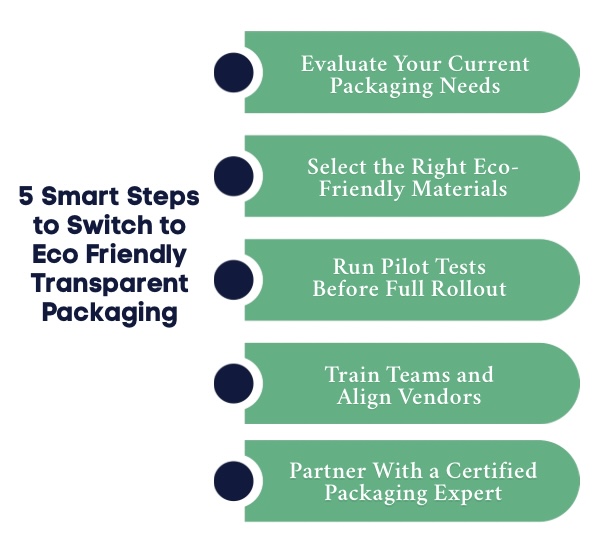
Shifting to sustainable packaging doesn’t have to be overwhelming. With a structured approach and the right partners, your business can adopt eco-friendly transparent solutions that align with regulatory, functional, and brand goals. Here’s how to make the transition smoothly:
1. Assess Your Current Packaging Footprint
Start by reviewing your existing packaging across all products. Consider the type of product, required durability, weight, and whether it involves direct food contact. This helps you understand where plastic can be replaced with eco-packaging without compromising functionality.
2. Choose the Right Materials
Once you’ve mapped your packaging needs, explore materials such as glassine paper, compostable PLA, or certified compostable film. Your selection should be based on clarity, shelf life, and barrier needs like moisture or scent protection, all while meeting compostability and safety standards.
3. Pilot Test With a Few SKUs
Before a full rollout, conduct pilot tests on a limited product range. Evaluate performance across a handful of various factors, such as sealing strength, oxygen transfer rate, visual appeal, and shelf stability. Feedback from this phase will inform packaging adjustments and vendor decisions.
4. Educate Your Teams and Vendors
Make sure your internal teams and packaging vendors are aligned on sustainability goals, disposal instructions, and compliance standards. Educating stakeholders ensures proper handling of compostable or recyclable materials throughout production, logistics, and post-consumer use.
5. Partner With a Trusted Packaging Provider
Work with experienced providers like Greenworksbio to ensure consistent quality, certified compostability, and packaging that meets Indian regulations. We help our partners avoid harmful residues, misleading green claims, and compliance risks, while offering tailored solutions built for your product, industry, and environment.
Explore more low-impact packaging inspirations in our blog: Looking for Creative and Eco-Friendly Packaging Ideas That Make a Difference?.
Why Choose Greenworksbio’s Compostable Transparent Bags?
At Greenworksbio, we’ve designed our compostable transparent bags to offer the best of both worlds: performance and planet-first responsibility. These bags are a certified, biodegradable alternative to plastic for packaging across food, retail, and healthcare industries. Made from a PLA + PBAT + natural fiber blend, they break down fully within 150–180 days under industrial composting, leaving no microplastics or harmful residues behind.
What makes our bags different?
- Visibility Without Plastic: They replace polypropylene and polyethylene with certified compostable clarity, making them perfect for shelf display or labeling.
- No Operational Change Needed: Compatible with existing packing workflows; no equipment changes required.
- Retail-Ready Durability: Lightweight yet strong, with customizable thickness and good load capacity.
- Zero-Waste Performance: Supports compost piles, reduces landfill burden, and meets ISO 17088 and CIPET standards.
- Food & Pharma Safe: Validated for direct food contact and used in pharmacies, groceries, apparel, cosmetics, and D2C brands.
Ready to make the switch to certified, high-performance compostable packaging? Contact us today, and let’s build a cleaner future together.
Ready to Rethink Transparent Packaging for a Greener Tomorrow?
The shift to eco-friendly transparent packaging isn’t just about meeting regulations; it’s about building a brand that’s future-proof, trusted, and aligned with what conscious consumers care about. With certified compostable solutions, your business can reduce its environmental impact without sacrificing performance, visibility, or shelf appeal.
Whether you’re in food, fashion, wellness, or eCommerce, now is the time to leave behind outdated plastics and embrace packaging that delivers clarity, in both purpose and sustainability.
Frequently Asked Questions
Is compostable transparent packaging waterproof?
Compostable materials like PLA and cellophane offer some water resistance but aren’t fully waterproof like plastic. However, high barrier coatings can enhance their moisture protection, making them suitable for packaging dry items without compromising sustainability or performance.
Is the cost of eco friendly transparent packaging worth it?
Yes, while the initial cost may be higher, the long-term benefits include regulatory compliance, improved brand reputation, and reduced environmental harm. It also aligns with sustainability goals and helps attract eco-conscious consumers who prefer responsible packaging.
Where can I buy certified compostable transparent bags for packaging?
You can buy certified compostable transparent bags from Greenworksbio, offering a range of plant-based, industrially compostable packaging made from PLA, PBAT, and natural fibers. Our bags are suitable for food, retail, and healthcare use, and are certified by CIPET, compliant with ISO 17088, and under review for TÜV Austria’s OK Compost Industrial certification.
How do compostable transparent packaging materials like cellophane compare to traditional plastic in terms of sustainability?
Compostable cellophane is made from renewable content and breaks down in months, leaving no harmful residues. In contrast, conventional plastic can linger in landfills for centuries, making compostables a cleaner, safer, and more responsible packaging solution.
Why is compostable transparent packaging the best eco-friendly choice for your business?
Compostable packaging breaks down fully without leaving microplastics, unlike recyclable or biodegradable options that may need special processing. It offers high clarity, strong barrier performance, and certified safety, making it the most complete, low-impact alternative to conventional plastic.

